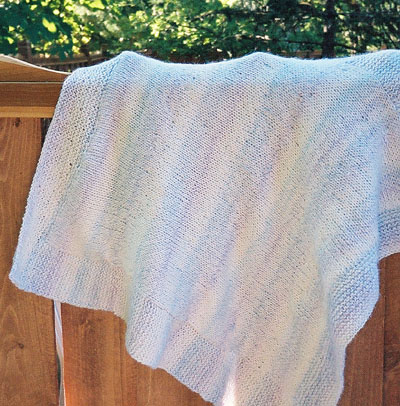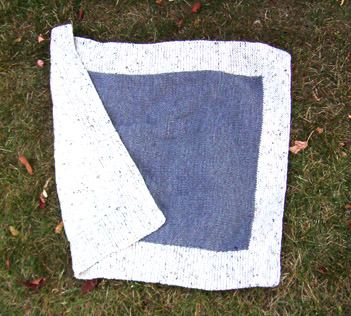Border
On a long circular needle,
CO 110 sts.
Work in Garter stitch [knit all rows] in MC
[main color] for 3 inches.
Preparation Row
K 15 sts for border. For the center
panel, you will need to double the number of stitches
so that both sides can be worked at the same time.
To do this, knit and purl into each stitch across
center 80 sts.
K last 15 sts for the border.

Variation 1: [blanket all of one
color - sample shown uses variegated yarn]

 Double
Knit Row
Double
Knit Row
K15 for border, K1, BRING
YARN TO FRONT [as if to purl], sl 1.
Continue in this fashion -- K1, sl 1 purlwise
-- across center panel. K15 for border.
You must slip the stitches as if to purl,
with the yarn in front, for the double-knitting
to work.
Work following rows the
same. You will always knit stitches
that are knit and slip the purled stitches
as if to purl.
When blanket is 3 inches
shorter than desired length, K15, *k2tog*
to last 15 sts, k15.
Work in Garter st until border
measures 3 inches. BO all.
A further caveat regarding the
border: Since Garter and Stockinette have different
row gauges, it may be wise to add extra border rows,
particularly if you have a wide border. This
can be done by knitting back and forth twice on
the border at regular intervals [every 6th
or 8th row]. Be sure that you add to
the borders equally at each side however, so your
blanket does not become lopsided. Mrs. Hoover is
rather vague on this point, but invites the knitter
to decide. "The border eats up more yarn per
number of stitches than the center does, so every
now and again you will have to put in an extra row
in the border, using your judgement and ingenuity
as to when that should be."
Worked like this, you will have
a double-knit blanket all of one color. Mrs. Hoover
recommends starting with this to understand the
technique. A smaller "swatch" might be
made in this fashion, as Mrs. Hoover said, "Perhaps
you know some one with a little doll!"

Variation 2:
[both sides single row stripes in two colors - recreation
of the original]


When working with two colors,
double-knit, you must always move both yarns together.
That is, both yarns should either be in front or
in back of the work, never one in front and one
in back. Unlike other two-color knitting, DO NOT
twist the yarns together between stitches.
"The only thing you have
to be careful about in all this is to keep your
two threads together between the two rows of stitches.
And not to let them get twisted around each other,
-- for in that case your two sides of the double
would be linked together! This is just a little
awkward at first, but soon becomes automatic."
Work Border and Preparation Row
as above with MC [white].
Please read the caveat about borders
above under Variation 1.
K 15 sts with MC [white] for border,
then attach CC yarn [blue].
*K1 CC, sl 1 purlwise* across row to border.
Turn and work back the same *K1 CC, sl 1 purlwise*.
K border with MC only.
Next row, switch back to MC and
work as above. You must work back and forth twice
across the border on the far side with MC to make
up for the rows you skipped last time.
Work back to beginning of row.
Continue in this fashion, alternating
two rows MC and two rows CC.
When blanket measures 3 inches
short of desired length, cut CC yarn, leaving tail
to weave in.
Work 3 inches in Garter st with MC then BO all sts.
A more elegant way to achieve
this same look is to hold both yarns together
and work all the center panel rows *K1 MC,
p1 CC*. The border will always be worked
in MC.
When
blanket measures 3 inches short of desired
length, cut CC yarn, leaving tail to weave
in. K15, *k2tog* to last 15 sts, k15 with
MC.
Work 3 inches in Garter st with MC then BO
all sts.

Variation 3: [two sides in two solid
colors]

 Work
Border and Preparation Row as above with MC.
Work
Border and Preparation Row as above with MC.
Please read the caveat about
borders above under Variation 1.
K 15 sts with MC for border,
then attach CC yarn.
With both yarns always held together,
work all RS rows of the center panel *K1 MC,
p1 CC*.
All WS rows are the reverse, *K1 CC, p1 MC*.
At end of center panel, wrap the MC yarn around
the CC yarn to keep edge between center and
border neat.
K border in MC only.
When
blanket measures 3 inches short of desired
length, cut CC yarn, leaving tail to weave
in. K15, *k2tog* to last 15 sts, k15 with
MC.
Work 3 inches in Garter st with MC then BO
all sts.

